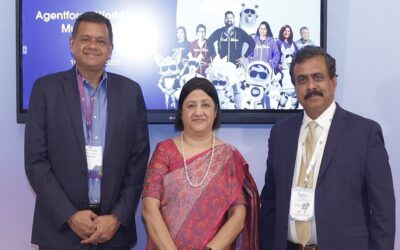India is a cash-based society where cash is king! The country’s youthful population have high aspirations and want to achieve status in society. That means a job; owning a house, a vehicle, a smartphone or a TV; marriage, or an international trip. Indians prefer to pay for all this with cash. And there are times when there is an urgent need for cash for medical emergencies, educational fees, house renovation; and financial assistance to recover from natural disasters (like floods, which are common in India). With no access to bureau credit, most borrowers turn to money lenders, family, friends, pawn shops or other sources of unorganised lending. These sources lend at high rates, often under predatory conditions. On the flip side, there is plenty of cash in the market for loans from banks and NBFCs. So there is high demand and high supply. But what is lacking is the credit intelligence layer – to access the creditworthiness of the borrower. This called for a unique model that could only be enabled by a Graph Database.
This is the premise on which the Mumbai-based Paysense was founded in 2015. Paysense is a venture-backed, financial services startup founded by Prashanth Ranganathan (CEO) and Sayali Karanjkar (Co-founder).
The company has raised $26 million in funding so far from investors like Nexus Venture (Series-A), Jungle Ventures (a Singapore-based fund), Naspers PayU (Series B) and rocketship.vc.
Paysense is addressing a fundamental problem of individuals not having simple, convenient and transparent access to credit in today’s India. It uses advanced data sciences to provide credit without the hassle of complex application processes, arduous physical proofs and long waits.
Paysense, which regards itself as a digital lending startup, is addressing a fundamental problem of individuals not having simple, convenient and transparent access to credit in today’s India. It has a lean team and depends heavily on technology. It uses advanced data sciences to provide credit without the hassle of complex application processes, arduous physical proofs and long waits.
Paysense has partnered with India’s leading NBFC, IIFL for loan disbursements. It serves 35 Lakh customers in 56 Indian cities.
Consumers can apply for loans up to Rs. 2 Lakhs from the Paysense website or app, and pay back on low interest EMIs.
By the end of the current financial year the company would have disbursed Rs 250 crore in loans.
Genesis
The co-founders met in Silicon Valley and have spent a considerable amount of time in the U.S. When they returned to India they saw a huge opportunity for offering formal credit through instant loans.

Prashanth Ranganathan, CEO, Paysense
Prashanth Ranganathan is passionate about building consumer products at scale. He spent the past 17 years building a career in product, tech and big data. Prior to founding Paysense, he was the head of Product for PayPal across Asia-Pacific. His experience at PayPal and Paysense taught him much about risk, credit, underwriting and collections–and how each of these can be fundamentally affected through the use of data and technology.
Sayali Karanjkar had logged more than 14 years in the U.S. and Singapore. She has worked in operational and strategic consultative roles in large corporations including AT&T and AT Kearney.
“India, from a formal credit standpoint, has about 40-45 million consumers who have access to formal credit and they are on the bureau,” said Ranganathan. “We saw a large, untapped, unserved market. We also observed that there was no dearth of supply, with plenty of money with the banks and NBFCs. What was missing was credit intelligence that brings the supply and the demand together. We founded this company on the basis of being able to augment what is already in the bureau, augment customer understanding in terms of lenders, and being able to serve a much broader base, with some intelligence.”
Paysense’s unique model establishes billions of relationships between millions of people. Today it has a graph with 318 million people connected a few billion times. This allows Paysense to evaluate the creditworthiness just based on the individual’s network. And this happens without even asking the individual for any information.
A unique model
In the last three years, Paysense issued a few hundred thousand loans. It continues to deepen partnerships with lenders and at the same time, it worked on the refinement of its systems.
It developed a unique model for accessing the creditworthiness of a borrower. Learning from the model he built at Paypal, Ranganathan decided that a network model was far more effective than a discrete model.
Given that India has a huge population, Paysense needed a model that could work at scale. It could not depend on humans to do the underwriting when dealing at scale. It needed to have a technology strategy that facilitates long-term scale.
“You get to a point where every on-going rupee is smarter in terms of its lending — we learn something from every rupee that comes back or doesn’t. And then you build scale to that. India is a country of scale,” said Ranganathan.
He had previously built network models for Paypal, where there was money moving in different formats across the world through various entities in the U.S. — through a very large, well-organised network. That experience thought him that the only way to address issues at scale was to look at a broader picture rather than analyse things at an individual level; it made sense to consider a network model with multiple connections.
“It’s not enough to know everything about an individual. I should be able to supplement that with information about people around you–people you are connected to and interact with; people you are more likely to behave like you. This is how microlending was done in the past. They did not lend to individuals; they lent to groups,” said Ranganathan.
Paysense decided to build the digital equivalent of that age-old practice of community lending. The unique network model it built was also designed to detect fraud.
But how does that model work? And what’s the enabling technology?
The business challenge was to scale up the technology once the tech was proven. Paysense needed a solution that provided high availability with minimum data loss. The solution would need to have a capability to handle connected datasets. Only a Graph Database could do this.
Technology Implementation
Paysense’s unique model establishes billions of relationships between millions of people. Today it has a graph with 318 million people connected a few billion times. This allows Paysense to evaluate the creditworthiness (predict credit behavior) of an individual in real-time — just based on the individual’s network. And this happens without even asking the individual for any information.
Traditional relational databases cannot handle this—and definitely not at scale. Paysense needed a Graph Database for its unique model.
A Graph Database stores both data and billions of relationships between the data. It can respond to queries in a few milliseconds. It is intended to hold data without constricting it to a pre-defined model.
There were no Graph Databases available back in 2015, and off-the-shelf solutions could not handle scale. So Paysense turned to open source solutions and also spent a lot of time and investment in developing home-grown technology.
Open source solutions also presented a set of challenges. The user needs to spend time to manage the software and that means patching and upgrading it. One also needs to check for backward compatibility. This takes up a lot of time with little time to focus on the core business.
“We were spending most of our time investing in the infrastructure and were spending very little time on the value creation on top of the infrastructure. Then we realized that it was better to let someone else handle the infrastructure and the innovation at a platform level,” said Ranganathan.
Graph Database
The business challenge was to scale up the technology once the tech was proven. Paysense needed a solution that provided high availability with minimum data loss. The solution would need to have a capability to handle connected datasets. Only a Graph Database could do this.
So when Amazon Neptune was launched last year Paysense immediately ported all its data to this platform, and was up and running within a week.
According to notes on the Amazon website, Amazon Neptune is a fast, reliable, fully managed graph database service that makes it easy to build and run applications that work with highly connected datasets. The core of Amazon Neptune is a purpose-built, high-performance graph database engine optimized for storing billions of relationships and querying the graph with milliseconds latency. Amazon Neptune supports popular graph models Property Graph and W3C’s RDF, and their respective query languages Apache TinkerPop Gremlin and SPARQL, allowing you to easily build queries that efficiently navigate highly connected datasets. Neptune powers graph use cases such as recommendation engines, fraud detection, knowledge graphs, drug discovery, and network security.
“We were one of the first customers in India for Neptune. We were already at a scale that AWS has not seen on that platform. Our data was built with relationships in mind. And we found that Neptune is best suited to handle this type of data,” said Ranganathan.
The first version of the implementation took a week and Paysense could then see some interesting results. Since it already had all the data and relationships, it just had to be converted for the Neptune format. The AWS bulk loader tools took care of that.
Being an early customer for Amazon Neptune did present mutual benefits for both Paysense and AWS. Paysense was using the pre-GA (General Availability) version of the product. As it began loading its data into Neptune, it observed that some features were missing in the product. So it worked closely with the AWS teams to refine the product. The benefit for Paysense was that it could get the product fine-tuned for its exact requirements.
“At some point we were talking directly to the AWS developers and product managers who were working on features and we were able to influence the prioritisation of those features to benefit us. We did run into a few snags but AWS has a phenomenal tech support infrastructure,” said Ranganathan.
More Benefits
Ranganathan said his company had benefitted immensely from the Amazon Neptune solution.
“The TCO is a lot lower than if we would have built our own infrastructure. It is about the lowest cost of experimentation while keeping scale in mind,” he said. “Our time to prove the network model has shrunk by a year and a half. We are already operating at such a massive scale. In terms of value, we have tripled down on this piece of intelligence.”
Apart from scale, there are business benefits too. Ranganathan informs us that the number of loans has almost doubled. And the delinquency on those loans has halved.
“Delinquency performance has doubled and our approval and lending rates have also increased,” he said.
The Graph Database also helps in mitigating fraud. “We can see all the fraud rings as they are connected. We have models that look for those. We know a particular rate at which a normal graph grows. But if we see an explosion in certain parts of the graph then we know that there is something strange going on. Earlier, it was difficult to detect fraud rings,” he said. “The only way to stem the bleed on fraud is by looking at a very broad picture. You look at the downstream implications of the money–AML, anti-terrorism, fraud etc.”
Apart from Neptune, Paysense is also using other Amazon solutions such as SageMaker for machine learning. Its servers run on Amazon EC2 and it has terabytes of data in various Amazon storage systems.
“Being a data company there are so many data processing solutions that AWS offers. So it does not make sense for us to look anywhere else to add another piece of technology,” said Ranganathan.
The road ahead
Moving ahead, Paysense will continue to deepen its partnerships with lenders. It wants to lend more based on its credit intelligence and less on credit bureau intelligence.
It will also focus more on borrowers in tier-2 and tier-3 cities in India. That’s where it sees the growth potential.
“The market is large enough — there is a large population that wants short-term credit. There is no dearth in supply or demand. But there is a dearth in intelligence. Companies that offer intelligence and in creating a long term, sustainable well-moated assets will survive,” concludes Ranganathan.
As of now, the company is focussing only on the Indian market, but it is confident of porting its technology to markets like India when the company is ready to go to those markets.
Related story
DISCLAIMER: THIS ARTICLE IS AN EDITORIAL INITIATIVE AND REGARDED AS EARNED CONTENT.









